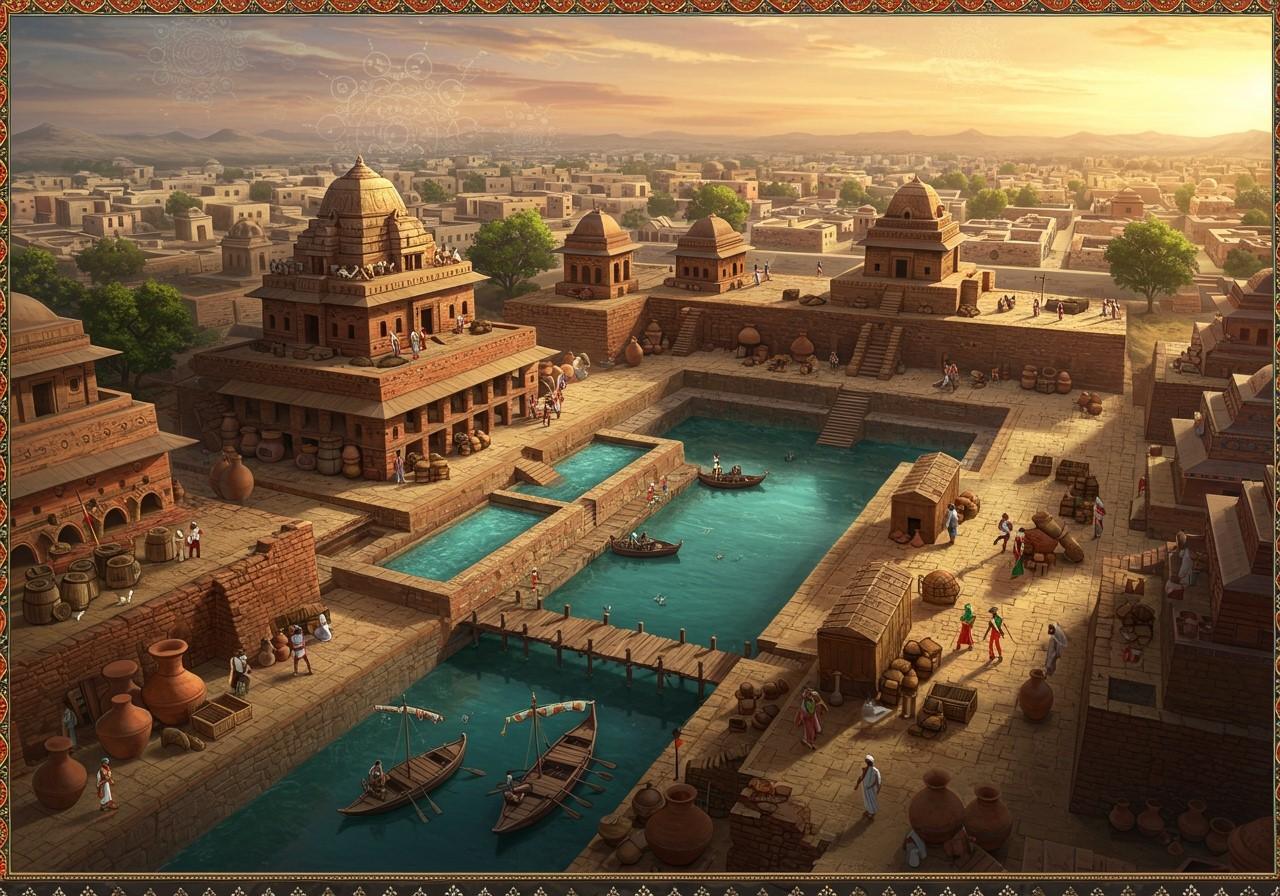
Lothal stands as a remarkable testament to the ingenuity of the Indus Valley Civilization. This ancient port city, nestled in the heart of Gujarat, India, offers a captivating glimpse into the advanced urban planning, maritime prowess, and vibrant trade networks that flourished thousands of years ago. Located along the Bhogava River in the Gulf of Khambhat, Lothal thrived between 2400 BCE and 1600 BCE. Its very name, derived from local and Sanskrit words, evokes its history, meaning “mound of the dead” or “place where boats are moored or repaired.” Spanning an area of 7.5 hectares, the site reveals layers of settlement, each whispering tales of a bygone era.
Location and Significance
Situated approximately 80 km southwest of Ahmedabad, Lothal’s strategic location near the Gulf of Khambhat, historically linked to the Arabian Sea, facilitated its prominence as a major trade hub. Nestled within the fertile Bhal region, near the Sabarmati River, Lothal’s position on the India map places it near the village of Saragwala in Dholka Taluka, Ahmedabad District. This advantageous location fueled its growth and influence within the Indus Valley Civilization.
Lothal’s significance is etched in its sophisticated urban planning, showcased by its meticulously designed dockyard, spacious warehouses, and well-organized residential areas. This meticulous planning underscores Lothal’s crucial role in maritime trade, connecting the Indus Valley with distant civilizations like Mesopotamia, Egypt, and Persia. The dockyard, constructed with baked bricks, stands as a testament to the engineering prowess of the time, expertly designed to manage tidal variations and streamline the loading and unloading of goods. Further emphasizing Lothal’s economic vitality, a thriving bead-making industry produced exquisite ornaments from semi-precious stones and shells, prized possessions that were traded far and wide. The city’s advanced drainage system, featuring covered drains and channels, further highlights the remarkable understanding of sanitation and urban infrastructure possessed by the inhabitants of Lothal.
Maritime Activities and Urban Planning
The dockyard at Lothal, an engineering marvel measuring approximately 218 meters long and 37 meters wide, stands as one of the earliest known structures of its kind. A channel ingeniously connected the dockyard to the Sabarmati River, allowing ships to safely dock during high tides. The presence of a nearby warehouse further solidifies Lothal’s role as a vital center for storing and distributing goods. Excavations have unearthed a trove of artifacts, including pottery, tools, and seals, offering tangible evidence of active trade with far-flung regions. The discovery of a bead factory adjacent to the dockyard underscores Lothal’s prominence in the production and export of luxury items, showcasing its economic dynamism.
Lothal’s urban layout reflects the sophisticated planning and architectural skills of the Indus Valley people. The city was thoughtfully divided into distinct sectors, accommodating residential areas, industrial zones, and public spaces. Streets, laid out in a grid pattern, formed well-defined blocks and intersections, demonstrating a structured approach to urban design. Houses, constructed with standardized bricks, featured courtyards, wells, and bathrooms, providing comfortable living spaces for the city’s inhabitants. The efficient drainage system, comprising channels and soak pits, ensured effective waste management and sanitation, contributing to the overall well-being of the community. Public buildings, such as the warehouse and bead factory, served as hubs of economic activity and social organization, further highlighting the city’s vibrant urban life.
Cultural and Economic Impact
Lothal’s cultural influence resonates through the artifacts and inscriptions discovered at the site. Seals and pottery offer valuable insights into the artistic and religious practices of the Indus Valley people. The city’s economic prosperity stemmed from its strategic location and advanced industries, including bead-making and metallurgy. Trade connections with Mesopotamia, Egypt, and Persia facilitated the exchange of goods, ideas, and technologies, enriching the cultural landscape. The discovery of weights and measures points to a standardized system of trade and commerce, further highlighting Lothal’s economic sophistication.
Preservation and Tourism
Today, Lothal stands as a protected archaeological site, drawing tourists and scholars eager to explore the wonders of ancient history and archaeology. The Archaeological Survey of India has implemented initiatives to preserve the site and promote its historical significance. Visitors can wander through the remnants of the dockyard, warehouses, residential areas, and bead factory, immersing themselves in the atmosphere of this ancient city. A nearby museum houses artifacts and exhibits related to the Indus Valley Civilization, providing a comprehensive understanding of Lothal’s pivotal role in ancient history. Ongoing efforts to promote sustainable tourism and educational programs ensure that this remarkable site will continue to inspire and educate future generations.
Connecting with Ancient Heritage through Poojn.in
Lothal’s legacy as a thriving port city reminds us of our rich cultural heritage. At Poojn.in, India’s leading cultural goods and services store, we empower you to connect with these ancient traditions through our authentic puja items and ritual materials. Inspired by Lothal’s historical significance, we offer a curated collection to enhance your spiritual practices:
- Complete Puja Kits: Ready-to-use sets containing all the essential items for traditional rituals, simplifying your preparations and ensuring a complete and fulfilling experience.
- Holy Utensils: Copper and brass vessels, reminiscent of those used in ancient times, add an authentic touch to your rituals, connecting you to the practices of our ancestors.
- Pure Puja Samagri: Traditional materials sourced with utmost care for authenticity, ensuring that your rituals are performed with the purest and most appropriate ingredients.
Poojn.in delivers across India, bringing authentic ritual items right to your doorstep.
FAQs
Where is Lothal located? Lothal is located in Gujarat, India.
What river is Lothal near? Lothal is located near the Bhogava River.
Why is Lothal significant? Lothal was an important port city of the Indus Valley Civilization, known for its advanced maritime activities and trade.


